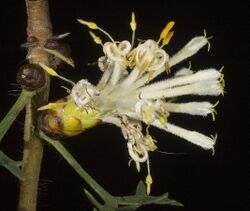Biology:Petrophile striata
| Petrophile striata | |
|---|---|

| |
| Scientific classification | |
| Kingdom: | Plantae |
| Clade: | Tracheophytes |
| Clade: | Angiosperms |
| Clade: | Eudicots |
| Order: | Proteales |
| Family: | Proteaceae |
| Genus: | Petrophile |
| Species: | P. striata
|
| Binomial name | |
| Petrophile striata R.Br.[1]
| |
| Synonyms[1] | |
| |
Petrophile striata is a species of flowering plant in the family Proteaceae and is endemic to southwestern Western Australia. It is a shrub with pinnate or bipinnate, striated, sharply-pointed leaves, and oval heads of silky-hairy yellow, creamy-yellow or cream-coloured flowers.
Description
Petrophile striata is a sometimes prostrate shrub that typically grows to a height of 0.2–1 m (7.9 in–3 ft 3.4 in) and has branchlets and leaves that are hairy when young but become glabrous with age. The leaves are pinnate or bipinnate, 35–75 mm (1.4–3.0 in) long on a petiole 10–22 mm (0.39–0.87 in) long and striated, the pinnae up to 10 mm (0.39 in) long, 1–3 mm (0.039–0.118 in) wide and sharply-pointed. The flowers are arranged in leaf axils in sessile, sometimes clustered, oval heads 5–6 mm (0.20–0.24 in) long, with overlapping egg-shaped involucral bracts at the base. The flowers are 15–20 mm (0.59–0.79 in) long, yellow, creamy-yellow or cream-coloured and silky-hairy. Flowering occurs from August to December and the fruit is a nut, fused with others in an oval head up to 16 mm (0.63 in) in diameter.[2][3]
Taxonomy
Petrophile striata was first formally described in 1830 by Robert Brown in the Supplementum to his Prodromus Florae Novae Hollandiae et Insulae Van Diemen from material collected by Charles Fraser near the Swan River in 1826.[4][5] The specific epithet (striata) refers to the leaves.[6]
Distribution and habitat
Petrophile striata grows in woodland and shrubland in sandy-clay-gravel soils over laterite or granite and is found from Eneabba to Wagin as well as on the Darling Range and nearby coastal plain.[2][3]
Conservation status
This petrophile is classified as "not threatened" by the Western Australian Government Department of Parks and Wildlife.[3]
References
- ↑ 1.0 1.1 "Petrophile striata". Australian Plant Census. https://biodiversity.org.au/nsl/services/apc-format/display/60885.
- ↑ 2.0 2.1 Foreman, David B.. "Petrophile striata". Australian Biological Resources Study, Department of Agriculture, Water and the Environment: Canberra. https://profiles.ala.org.au/opus/foa/profile/Petrophile%20striata.
- ↑ 3.0 3.1 3.2 "Petrophile striata". FloraBase. Western Australian Government Department of Parks and Wildlife. https://florabase.dpaw.wa.gov.au/browse/profile/2312.
- ↑ "Petrophile striata". APNI. https://id.biodiversity.org.au/instance/apni/466189.
- ↑ Brown, Robert (1830). Supplementum primum prodromi florae Novae Hollandiae. London. p. 6. https://www.biodiversitylibrary.org/item/77294#page/519/mode/1up. Retrieved 8 January 2021.
- ↑ Sharr, Francis Aubi; George, Alex (2019). Western Australian Plant Names and Their Meanings (3rd ed.). Kardinya, WA: Four Gables Press. p. 315. ISBN 9780958034180.
Wikidata ☰ Q18075590 entry
 |

